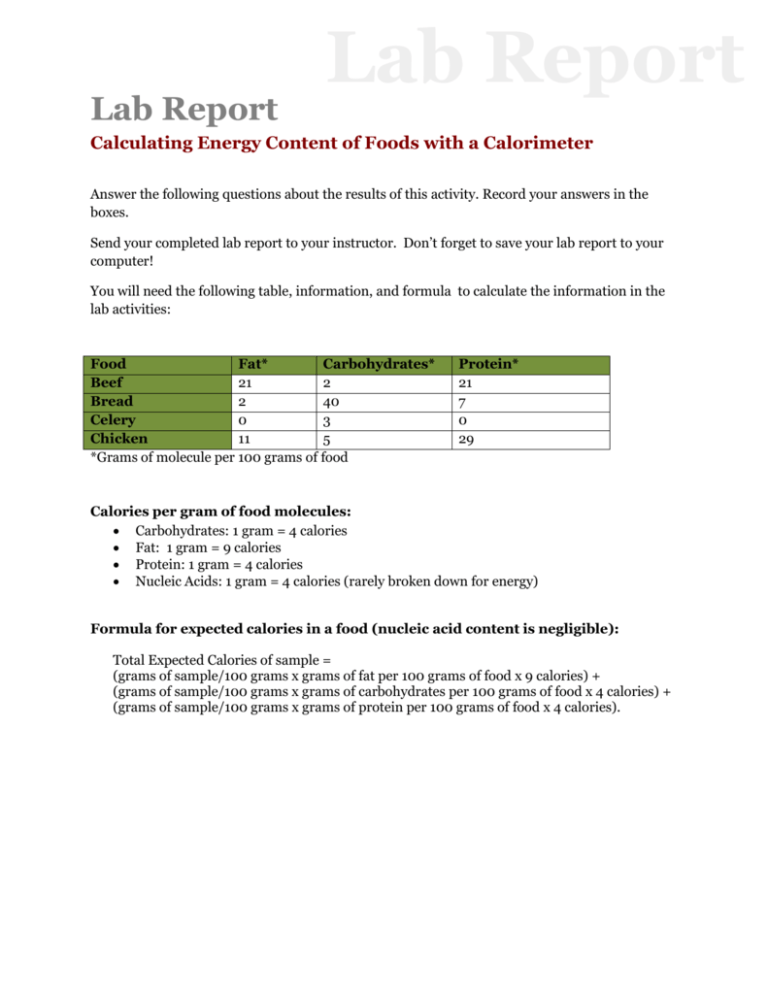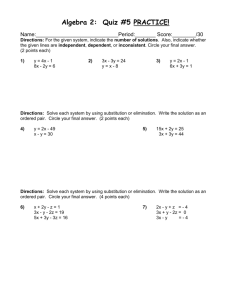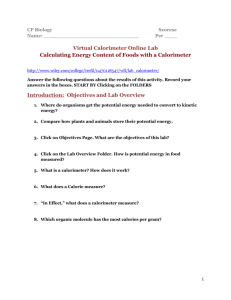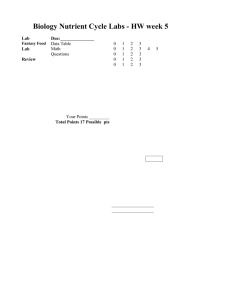Lab Report
advertisement

Lab Report Lab Report Calculating Energy Content of Foods with a Calorimeter Answer the following questions about the results of this activity. Record your answers in the boxes. Send your completed lab report to your instructor. Don’t forget to save your lab report to your computer! You will need the following table, information, and formula to calculate the information in the lab activities: Food Fat* Carbohydrates* Beef 21 2 Bread 2 40 Celery 0 3 Chicken 11 5 *Grams of molecule per 100 grams of food Protein* 21 7 0 29 Calories per gram of food molecules: Carbohydrates: 1 gram = 4 calories Fat: 1 gram = 9 calories Protein: 1 gram = 4 calories Nucleic Acids: 1 gram = 4 calories (rarely broken down for energy) Formula for expected calories in a food (nucleic acid content is negligible): Total Expected Calories of sample = (grams of sample/100 grams x grams of fat per 100 grams of food x 9 calories) + (grams of sample/100 grams x grams of carbohydrates per 100 grams of food x 4 calories) + (grams of sample/100 grams x grams of protein per 100 grams of food x 4 calories). Activity 1 – Calibration Record your data from Activity 1 in the boxes below. Enter the data you collected for the samples you tested (carbohydrates, fat, protein, nucleic acids) in the “Readout Calories” columns. Then calculate the theoretical caloric content of the carbohydrates, fat, protein, and nucleic acids samples based on the table and information given above. Place the answers in the “Expected Calories” columns. Sample Carbohydrates Fat Protein Nucleic Acids Readout Calories Expected Calories 1. Is the calorimeter accurate enough for use in an experiment? Explain. Activity 2 Record your data from Activity 2 in the boxes below. Enter the data you collected for the samples you tested (beef, bread, celery, chicken) in the appropriate columns (weight in grams, readout calories). Then calculate the theoretical caloric content of the food based on its composition of carbohydrates, fat, protein, nucleic acids samples based on the table and formula given above. Place the answers in the “Expected Calories” columns. Food Weight in Grams Readout Calories Expected Calories Beef Bread Celery Chicken 2. Explain why the grams of the nutrient molecules in a food do not add up to the total gram weight of the food. 3. Explain why the calorimeter value varied from the expected caloric content calculated for each food. Activity 3 Record your data from Activity 3 in the boxes below. Enter the data you collected for the samples you tested (beef, bread, celery, chicken) in the columns for the appropriated animals (cow, dog, rat, human). Sample Beef Bread Celery Chicken Cow Dog Rat Human 4. Explain why there might be differences in the calorie calculations for the different animals. 5. Explain why it is important to know that animals vary in their ability to obtain calories from food.







